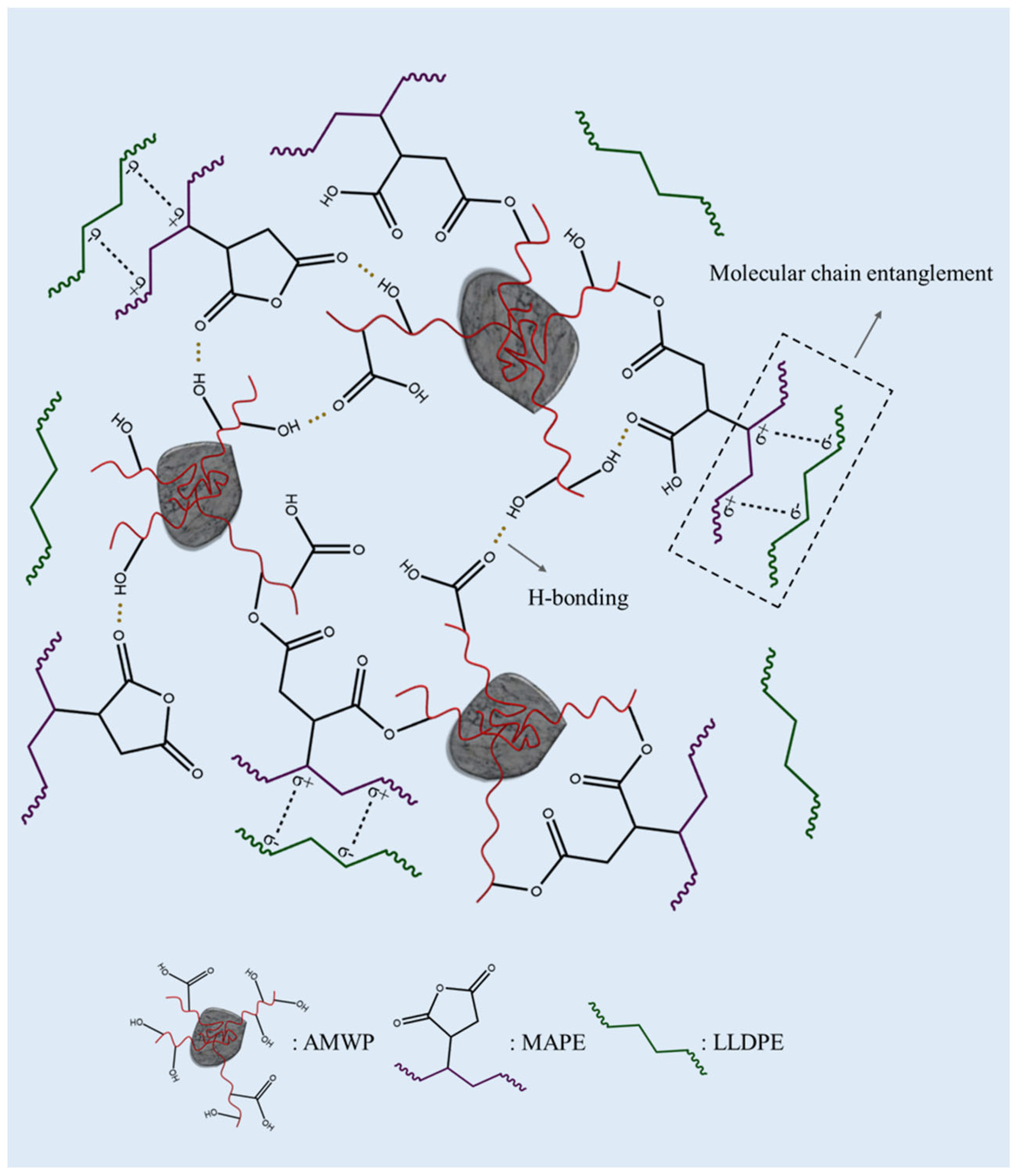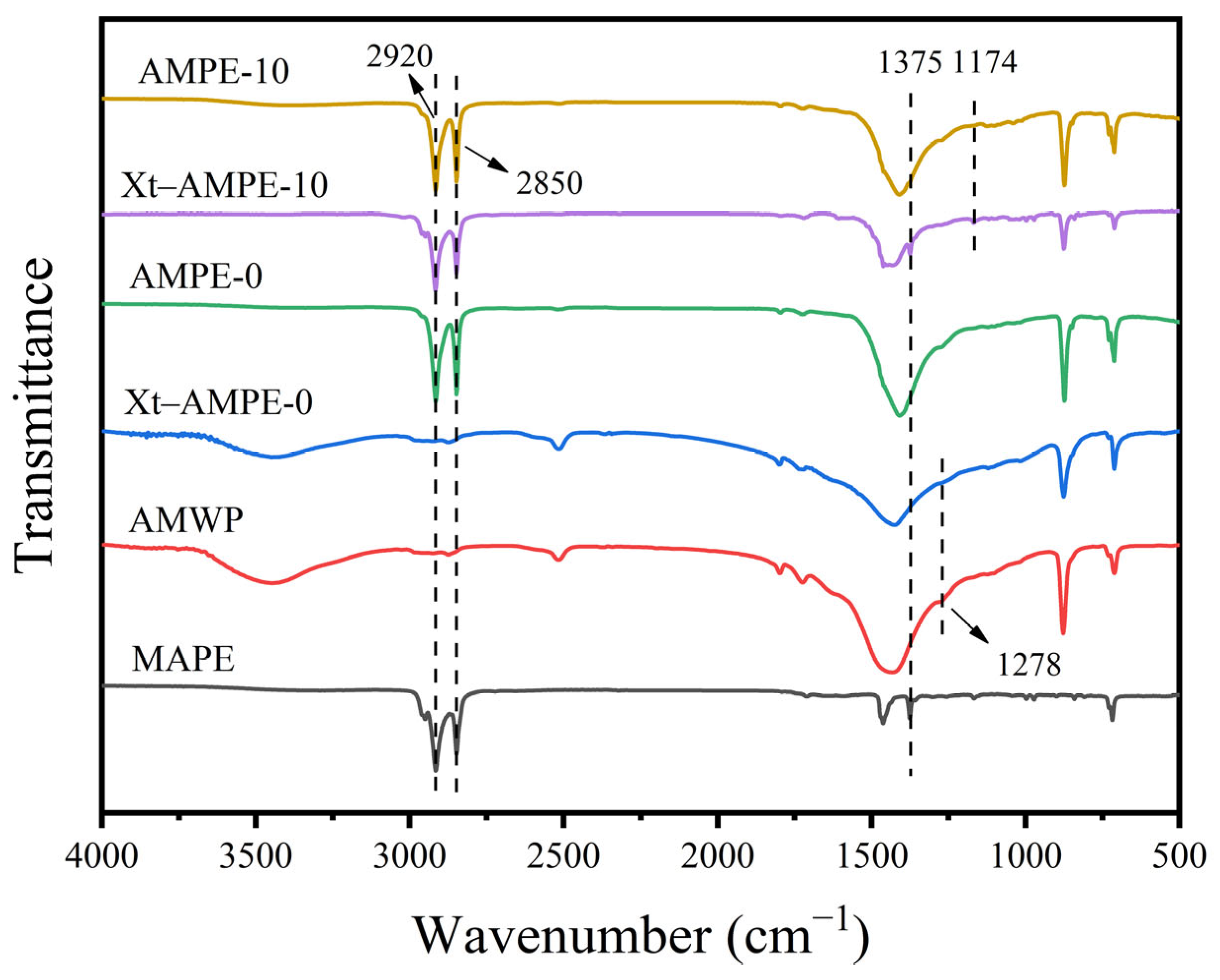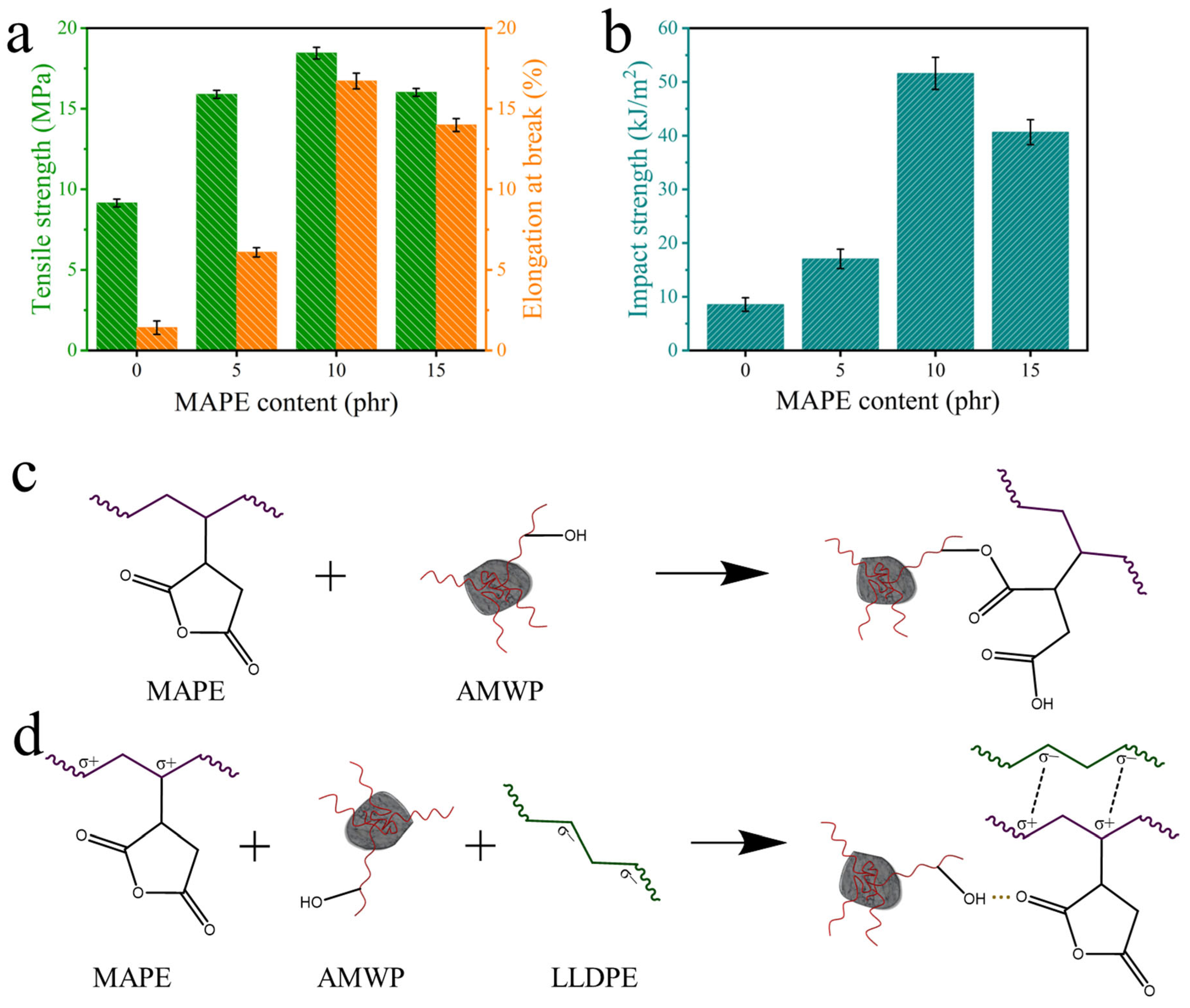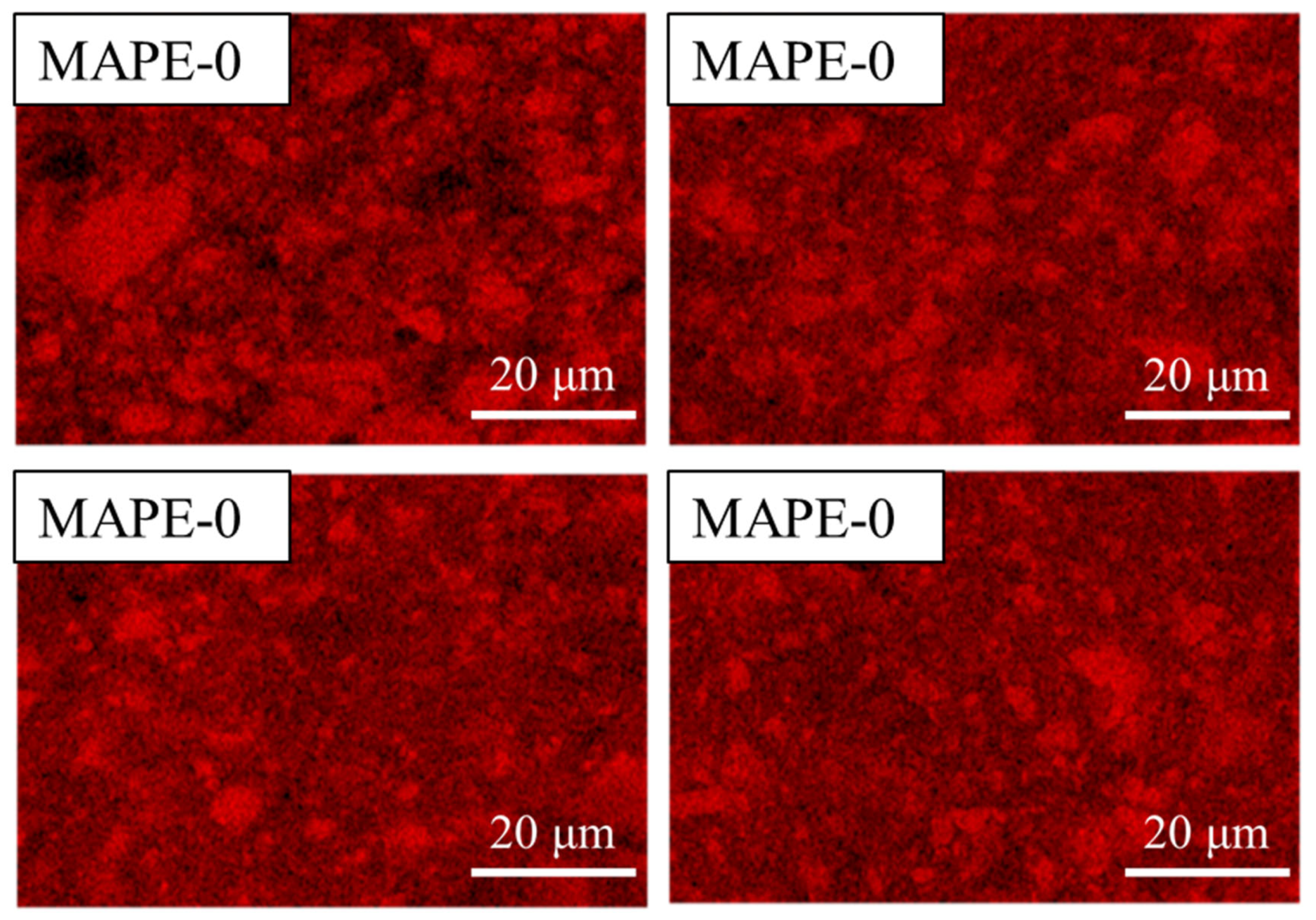Effects of Maleic Anhydride-Grafted Polyethylene on the Properties of Artificial Marble Waste Powder/Linear Low-Density Polyethylene Composites with Ultra-High Filling Content
Abstract
:1. Introduction
2. Materials and Methods
2.1. Materials
2.2. Preparation of AMWP/LLDPE Composites
2.3. Characterization
2.3.1. Sample Purification
2.3.2. Fourier Transform Infrared (FTIR) Spectroscopy
2.3.3. Scanning Electron Microscopy (SEM) and Energy Dispersive X-ray Spectroscopy (EDS)
2.3.4. Thermogravimetric Analysis (TGA)
2.3.5. Tensile Test
2.3.6. Impact Test
3. Results and Discussion
3.1. Materials Design
3.2. FTIR Spectroscopy Analysis
3.3. Mechanical Properties of AMWP/LLDPE Composites
3.4. SEM and EDS Analysis of Tensile Sections of AMWP/LLDPE Composites
3.5. Thermogravimetric Analysis
4. Conclusions
Author Contributions
Funding
Institutional Review Board Statement
Informed Consent Statement
Data Availability Statement
Conflicts of Interest
References
- Zhao, Y.; Su, Q.; Li, B.; Zhang, Y.; Wang, X.; Zhao, H.; Guo, S. Have those countries declaring “zero carbon” or “carbon neutral” climate goals achieved carbon emissions-economic growth decoupling? J. Clean. Prod. 2022, 363, 132450. [Google Scholar] [CrossRef]
- Uygunoğlu, T.; Topçu, İ.B.; Çelik, A.G. Use of waste marble and recycled aggregates in self-compacting concrete for environmental sustainability. J. Clean. Prod. 2014, 84, 691–700. [Google Scholar] [CrossRef]
- Ashish, D.K. Feasibility of waste marble powder in concrete as partial substitution of cement and sand amalgam for sustainable growth. J. Build. Eng. 2018, 15, 236–242. [Google Scholar] [CrossRef]
- Bilgin, N.; Yeprem, H.A.; Arslan, S.; Bilgin, A.; Günay, E.; Marşoglu, M. Use of waste marble powder in brick industry. Constr. Build. Mater. 2012, 29, 449–457. [Google Scholar] [CrossRef]
- Nayak, S.K.; Satapathy, A.; Mantry, S. Use of waste marble and granite dust in structural applications: A review. J. Build. Eng. 2022, 46, 103742. [Google Scholar] [CrossRef]
- Ribeiro, C.E.G.; Rodriguez, R.J.S.; Vieira, C.M.F.; de Carvalho, E.A.; Candido, V.S.; Monteiro, S.N. Production of synthetic ornamental marble as a marble waste added polyester composite. Mater. Sci. Forum 2014, 775–776, 341–345. [Google Scholar] [CrossRef]
- Chen, H.; He, H.; Tian, S.; Chen, S. Recycling of waste artificial marble powder in HDPE-wood composites. Polym. Compos. 2018, 39, 2347–2355. [Google Scholar] [CrossRef]
- Seghir, N.T.; Mellas, M.; Sadowski, Ł.; Żak, A. Effects of marble powder on the properties of the air-cured blended cement paste. J. Clean. Prod. 2018, 183, 858–868. [Google Scholar] [CrossRef]
- Singh, T.; Puri, M.; Tejyan, S.; Ravi, R.K. Abrasive wear and dynamic–mechanical behavior of marble dust filled bagasse fiber reinforced hybrid polymer composites. Polym. Compos. 2021, 42, 2817–2828. [Google Scholar] [CrossRef]
- Lu, H.; Chen, K.; Yang, X.; Liu, J.; Huang, X.; Lv, Z.; Zhang, X. Use of titanate to improve interfacial interaction and mechanical properties of polyethylene/artificial marble wastes composites. J. Vinyl Addit. Technol. 2021, 27, 137–146. [Google Scholar] [CrossRef]
- Li, H.; Ji, D.; Chen, C.; Wang, X.; Tu, J.; Zhang, K.; Ding, A. Effect of fatty acid methyl ester polyoxyethylene ether on the rheological properties of cement filled with artificial marble waste powders. J. Clean. Prod. 2021, 328, 129503. [Google Scholar] [CrossRef]
- Huang, X.; Guo, Q.; Zhou, P.; Lu, C.; Yuan, G.; Chen, Z.; Zhang, X. Poly (vinyl alcohol)/artificial marble wastes composites with improved melt processability and mechanical properties. Compos. Part B Eng. 2020, 182, 107628. [Google Scholar] [CrossRef]
- Jehanno, C.; Alty, J.W.; Roosen, M.; De Meester, S.; Dove, A.P.; Chen, E.Y.-X.; Leibfarth, F.A.; Sardon, H. Critical advances and future opportunities in upcycling commodity polymers. Nature 2022, 603, 803–814. [Google Scholar] [CrossRef]
- Guo, Q.; Xue, R.; Zhao, J.; Zhang, Y.; van de Kerkhof, G.T.; Zhang, K.; Li, Y.; Vignolini, S.; Song, D.P. Precise Tailoring of Polyester Bottlebrush Amphiphiles toward Eco-Friendly Photonic Pigments via Interfacial Self-Assembly. Angew. Chem. Int. Ed. 2022, 61, e202206723. [Google Scholar] [CrossRef]
- Pearson, A.; Duncan, M.; Hammami, A.; Naguib, H.E. Interfacial adhesion and thermal stability of high-density polyethylene glass fiber composites. Compos. Sci. Technol. 2022, 227, 109570. [Google Scholar] [CrossRef]
- Mészáros, L.; Tatár, B.; Toth, K.; Földes, A.; Nagy, K.S.; Jedlovszky-Hajdu, A.; Tóth, T.; Molnár, K. Novel, injection molded all-polyethylene composites for potential biomedical implant applications. J. Mater. Res. Technol. 2022, 17, 743–755. [Google Scholar] [CrossRef]
- Shi, L.; Hou, Y.; Chen, Z.; Bu, Y.; Zhang, X.; Shen, Z.; Chen, Y. Impact of polyethylene on soil physicochemical properties and characteristics of sweet potato growth and polyethylene absorption. Chemosphere 2022, 302, 134734. [Google Scholar] [CrossRef]
- Lu, W.; Yu, W.; Zhang, B.; Dou, X.; Han, X.; Cai, H. Kevlar fibers reinforced straw wastes-polyethylene composites: Combining toughness, strength and self-extinguishing capabilities. Compos. Part B Eng. 2021, 223, 109117. [Google Scholar] [CrossRef]
- Wangtueai, S.; Chaiyaso, T.; Rachtanapun, P.; Jantrawut, P.; Ruksiriwanich, W.; Seesuriyachan, P.; Leksawasdi, N.; Phimolsiripol, Y.; Techapun, C.; Phongthai, S. Thermoplastic cassava starch blend with polyethylene-grafted-maleic anhydride and gelatin core-shell structure compatibilizer. Int. J. Biol. Macromol. 2022, 197, 49–54. [Google Scholar] [CrossRef]
- Hao, X.; Xu, J.; Zhou, H.; Tang, W.; Li, W.; Wang, Q.; Ou, R. Interfacial adhesion mechanisms of ultra-highly filled wood fiber/polyethylene composites using maleic anhydride grafted polyethylene as a compatibilizer. Mater. Des. 2021, 212, 110182. [Google Scholar] [CrossRef]
- Jantanasakulwong, K.; Leksawasdi, N.; Seesuriyachan, P.; Wongsuriyasak, S.; Techapun, C.; Ougizawa, T. Reactive blending of thermoplastic starch and polyethylene-graft-maleic anhydride with chitosan as compatibilizer. Carbohydr. Polym. 2016, 153, 89–95. [Google Scholar] [CrossRef]
- Atli, A.; Noyel, J.-P.; Hajjar, A.; Antouly, K.; Lemaire, E.; Simon, S. Exploring the mechanical performance of BaTiO3 filled HDPE nanocomposites: A comparative study of the experimental and numerical approaches. Polymer 2022, 254, 125063. [Google Scholar] [CrossRef]
- Awad, A.; Abdel-Ghany, A.W.; Abd El-Wahab, A.A.; El-Gamasy, R.; Abdellatif, M.H. The influence of adding marble and granite dust on the mechanical and physical properties of PP composites. J. Therm. Anal. Calorim. 2020, 140, 2615–2623. [Google Scholar] [CrossRef]
- Awad, A.; Abdellatif, M.H. Assessment of mechanical and physical properties of LDPE reinforced with marble dust. Compos. Part B Eng. 2019, 173, 106948. [Google Scholar] [CrossRef]
- Al-Samhan, M.; Al-Attar, F. Comparative analysis of the mechanical, thermal and barrier properties of polypropylene incorporated with CaCO3 and nano CaCO3. Surf. Interfaces 2022, 31, 102055. [Google Scholar] [CrossRef]
- Di, X.; Zhang, Y.; Zhang, N.; Ding, C.; Li, Y.; Zhang, Y. Toughening action in marble tailings/PVC composite plates: Rheological and mechanical properties. Constr. Build. Mater. 2022, 340, 127680. [Google Scholar] [CrossRef]
- Ror, C.K.; Tejyan, S.; Kumar, N. Effect of marble dust reinforcement in composites for different applications: A review. Mater. Today Proc. 2022, 60, 1120–1124. [Google Scholar] [CrossRef]
- Liu, Q.; Xia, C.; He, C.; Guo, W.; Wu, Z.P.; Li, Z.; Zhao, Q.; Xia, B.Y. Dual-Network Structured Hydrogel Electrolytes Engaged Solid-State Rechargeable Zn-Air/Iodide Hybrid Batteries. Angew. Chem. 2022, 134, e202210567. [Google Scholar] [CrossRef]
- Mu, X.; Zhou, J.; Wang, P.; Chen, H.; Yang, T.; Chen, S.; Miao, L.; Mori, T. A robust starch–polyacrylamide hydrogel with scavenging energy harvesting capacity for efficient solar thermoelectricity–freshwater cogeneration. Energy Environ. Sci. 2022, 15, 3388–3399. [Google Scholar] [CrossRef]
- Mohit, H.; Mavinkere Rangappa, S.; Yorseng, K.; Siengchin, S.; Marwani, H.M.; Khan, A.; Asiri, A.M. Discarded water hyacinth/pineapple fibers and carbon/innegra fabrics and TiC nanoparticles reinforced UV resistant polyester composites. J. Mater. Res. Technol. 2023, 24, 5059–5081. [Google Scholar] [CrossRef]
- Cao, B.; Zhou, Y.; Wu, Y.; Cai, J.; Guan, X.; Liu, S.; Zhao, J.; Zhang, M. Simultaneous improvement of processability and toughness of highly filled MH/LLDPE composites by using fluorine-containing flow modifiers. Compos. Part A Appl. Sci. Manuf. 2020, 134, 105900. [Google Scholar] [CrossRef]
- Azoug, A.; Nevière, R.; Pradeilles-Duval, R.M.; Constantinescu, A. Influence of crosslinking and plasticizing on the viscoelasticity of highly filled elastomers. J. Appl. Polym. Sci. 2014, 131, 40392. [Google Scholar] [CrossRef]
- Song, M.-X.; Xie, L.-J.; Cheng, J.-Y.; Yi, Z.-L.; Song, G.; Jia, X.-Y.; Chen, J.-P.; Guo, Q.-G.; Chen, C.-M. Insights into the thermochemical evolution of maleic anhydride-initiated esterified starch to construct hard carbon microspheres for Lithium-ion batteries. J. Energy Chem. 2022, 66, 448–458. [Google Scholar] [CrossRef]
- Watanabe, R.; Sugahara, A.; Hagihara, H.; Mizukado, J.; Shinzawa, H. Insight into interfacial compatibilization of glass-fiber-reinforced polypropylene (PP) using maleic-anhydride modified PP employing infrared spectroscopic imaging. Compos. Sci. Technol. 2020, 199, 108379. [Google Scholar] [CrossRef]
- Luo, X.; Wei, Z.; Seo, B.; Hu, Q.; Wang, X.; Romo, J.A.; Jain, M.; Cakmak, M.; Boudouris, B.W.; Zhao, K. Circularly Recyclable Polymers Featuring Topochemically Weakened Carbon–Carbon Bonds. J. Am. Chem. Soc. 2022, 144, 16588–16597. [Google Scholar] [CrossRef]
- Huang, C.-W.; Yang, T.-C.; Wu, T.-L.; Hung, K.-C.; Wu, J.-H. Effects of maleated polypropylene content on the extended creep behavior of wood–polypropylene composites using the stepped isothermal method and the stepped isostress method. Wood Sci. Technol. 2018, 52, 1313–1330. [Google Scholar] [CrossRef]
- Khan, A.; Patidar, R.; Pappu, A. Marble waste characterization and reinforcement in low density polyethylene composites via injection moulding: Towards improved mechanical strength and thermal conductivity. Constr. Build. Mater. 2021, 269, 121229. [Google Scholar] [CrossRef]
- Huang, C.-W.; Yang, T.-C.; Hung, K.-C.; Xu, J.-W.; Wu, J.-H. The effect of maleated polypropylene on the non-isothermal crystallization kinetics of wood fiber-reinforced polypropylene composites. Polymers 2018, 10, 382. [Google Scholar] [CrossRef]
- Gao, H.; Xie, Y.; Ou, R.; Wang, Q. Grafting effects of polypropylene/polyethylene blends with maleic anhydride on the properties of the resulting wood–plastic composites. Compos. Part A Appl. Sci. Manuf. 2012, 43, 150–157. [Google Scholar] [CrossRef]
- Li, X.; Yang, Q.; Zhang, K.; Pan, L.; Feng, Y.; Jia, Y.; Xu, N. Property improvement and compatibilization mechanism of biodegradable polylactic acid/maleic anhydride-based/polypropylene spunbonded nonwoven slices. J. Clean. Prod. 2022, 375, 134097. [Google Scholar] [CrossRef]
- Song, P.; Xu, Z.; Lu, Y.; Guo, Q. Bio-inspired hydrogen-bond cross-link strategy toward strong and tough polymeric materials. Macromolecules 2015, 48, 3957–3964. [Google Scholar] [CrossRef]
- Chaudhary, A.; Lakhani, J.; Dalsaniya, P.; Chaudhary, P.; Trada, A.; Shah, N.K.; Upadhyay, D.S. Slow pyrolysis of low-density Poly-Ethylene (LDPE): A batch experiment and thermodynamic analysis. Energy 2023, 263, 125810. [Google Scholar] [CrossRef]
- Zhu, Y.; Wang, Z.; Chen, Z.; Lin, C.; Li, P.; Huang, Z.; Cai, P.; Wu, C.; Zeng, Q. High value-added utilization of artificial marble wastes and potential applications in biodegradable sustainable packaging. Compos. Sci. Technol. 2022, 229, 109682. [Google Scholar] [CrossRef]








| Ingredients Phr | Formulation Code | |||
|---|---|---|---|---|
| AMPE-0 | AMPE-5 | AMPE-10 | AMPE-15 | |
| AMWP | 70 | 70 | 70 | 70 |
| LLDPE | 30 | 30 | 30 | 30 |
| MAPE | 0 | 5 | 10 | 15 |
| Sample | AMPE-0 | AMPE-5 | AMPE-10 | AMPE-15 |
|---|---|---|---|---|
| Tensile strength (MPa) | 9.15 ± 0.24 | 15.89 ± 0.25 | 18.45 ± 0.36 | 16.01 ± 0.25 |
| Elongation at break (%) | 1.42 ± 0.41 | 6.09 ± 0.29 | 16.72 ± 0.49 | 13.99 ± 0.40 |
| Impact strength (kJ/m2) | 8.57 ± 1.26 | 17.06 ± 1.81 | 51.60 ± 2.99 | 40.66 ± 2.33 |
Disclaimer/Publisher’s Note: The statements, opinions and data contained in all publications are solely those of the individual author(s) and contributor(s) and not of MDPI and/or the editor(s). MDPI and/or the editor(s) disclaim responsibility for any injury to people or property resulting from any ideas, methods, instructions or products referred to in the content. |
© 2023 by the authors. Licensee MDPI, Basel, Switzerland. This article is an open access article distributed under the terms and conditions of the Creative Commons Attribution (CC BY) license (https://creativecommons.org/licenses/by/4.0/).
Share and Cite
Die, J.; Ma, J.; Li, H.; Zhang, Y.; Li, F.; Cao, Y.; Hao, W.; Tu, J.; Zhang, K.; Yu, R. Effects of Maleic Anhydride-Grafted Polyethylene on the Properties of Artificial Marble Waste Powder/Linear Low-Density Polyethylene Composites with Ultra-High Filling Content. Materials 2023, 16, 4036. https://doi.org/10.3390/ma16114036
Die J, Ma J, Li H, Zhang Y, Li F, Cao Y, Hao W, Tu J, Zhang K, Yu R. Effects of Maleic Anhydride-Grafted Polyethylene on the Properties of Artificial Marble Waste Powder/Linear Low-Density Polyethylene Composites with Ultra-High Filling Content. Materials. 2023; 16(11):4036. https://doi.org/10.3390/ma16114036
Chicago/Turabian StyleDie, Juncheng, Jianting Ma, Hai Li, Yafeng Zhang, Fei Li, Yang Cao, Wanjun Hao, Jinchun Tu, Kexi Zhang, and Rentong Yu. 2023. "Effects of Maleic Anhydride-Grafted Polyethylene on the Properties of Artificial Marble Waste Powder/Linear Low-Density Polyethylene Composites with Ultra-High Filling Content" Materials 16, no. 11: 4036. https://doi.org/10.3390/ma16114036





